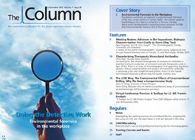Biomonitoring POPs Using Fish Bile
A new method for the simultaneous determination of emerging and persistent organic pollutants (POPs) in fish bile samples has been developed using gas chromatography–mass spectrometry (GC–MS).
Photo Credit: Nick Free/Getty Images

A new method for the simultaneous determination of emerging and persistent organic pollutants (POPs) in fish bile samples has been developed using gas chromatography–mass spectrometry (GC–MS).1
POPs can persist for long periods of time in the environment and can accumulate and pass from one species to the next through the food chain. In the current study the target compounds included musk fragrances, alkyl phenols, hormones, pesticides, phthalate esters, and bisphenol-A, which are known to have an endocrine disrupting effect. Lead author of the study, Asier Vallejo, explained to The Column: “Endocrine disrupting compounds may cause different alterations in fish population such as feminization, intersex, decreased fertility and fecundity, and developmental abnormalities.”
Thicklip grey mullets (Chelon labrosus) from five different populations of the Basque Coast (Ondarroa, Deba, Gernika, Santurtzi, and Pasaia) were selected as the study subjects. Bile samples from the fish were analyzed using GC–MS. Good recoveries (75–125%), repeatability (<20%), and limits of detection (LODs) ranging between 0.04 and 459 ng/mL were obtained. The target analytes were found at concentrations ranging from <LOD to 19,226 ng/mL. Bioconcentration factors (log BCF) were found to be 2.42–5.55. Vallejo commented: “As we expected, the highest BCF values and most contaminated site is the sampling point located near the WWTP of Gernika. It is worth mentioning that the BCF values are higher in males than intersex and in intersex than female organisms. Although Gernika is the most contaminated point, we also detected intersex fish in Pasaia and Deba.”
The team concluded that fish bile is suitable for biomonitoring purposes. The study results could indicate a relationship between the analyte concentration in the water samples with the number of intersex fish, as in the
case of Gernika, but no clear relation was observed between the intersex condition and the analytes in the
fish bile. “We are looking for where exactly these compounds are accumulated (brain, muscles, liver, or bile)
in order to determine the BCF values. We would [also] like to correlate these values with the
amount of intersex fish,” Vallejo added. - K.M.
Reference
1. Asier Vallejo et al., Science of the Total Environment536, 261–267 (2015).

Determining Enhanced Sensitivity to Odors due to Anxiety-Associated Chemosignals with GC
May 8th 2025Based on their hypothesis that smelling anxiety chemosignals can, like visual anxiety induction, lead to an increase in odor sensitivity, a joint study between the University of Erlangen-Nuremberg (Erlangen, Germany) and the Fraunhofer Institute for Process Engineering and Packaging (Freising, Germany) combined behavioral experiments, odor profile analysis by a trained panel, and instrumental analysis of odorants (gas chromatography-olfactometry) and volatiles (gas chromatography-mass spectrometry).
Investigating 3D-Printable Stationary Phases in Liquid Chromatography
May 7th 20253D printing technology has potential in chromatography, but a major challenge is developing materials with both high porosity and robust mechanical properties. Recently, scientists compared the separation performances of eight different 3D printable stationary phases.
Detecting Hyper-Fast Chromatographic Peaks Using Ion Mobility Spectrometry
May 6th 2025Ion mobility spectrometers can detect trace compounds quickly, though they can face various issues with detecting certain peaks. University of Hannover scientists created a new system for resolving hyper-fast gas chromatography (GC) peaks.

.png&w=3840&q=75)

.png&w=3840&q=75)



.png&w=3840&q=75)



.png&w=3840&q=75)










